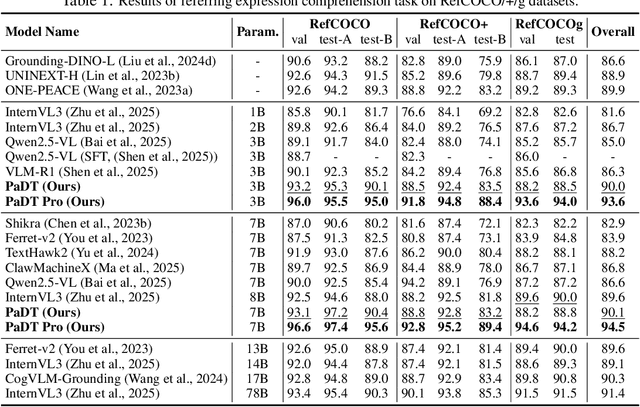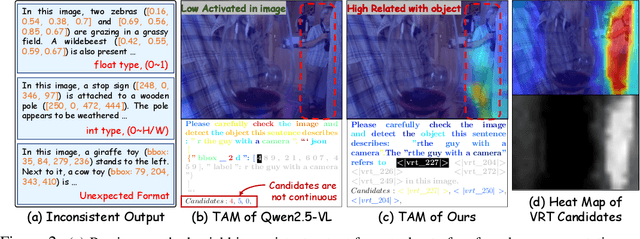Chen Li
Beihang University
V-Thinker: Interactive Thinking with Images
Nov 06, 2025Abstract:Empowering Large Multimodal Models (LMMs) to deeply integrate image interaction with long-horizon reasoning capabilities remains a long-standing challenge in this field. Recent advances in vision-centric reasoning explore a promising "Thinking with Images" paradigm for LMMs, marking a shift from image-assisted reasoning to image-interactive thinking. While this milestone enables models to focus on fine-grained image regions, progress remains constrained by limited visual tool spaces and task-specific workflow designs. To bridge this gap, we present V-Thinker, a general-purpose multimodal reasoning assistant that enables interactive, vision-centric thinking through end-to-end reinforcement learning. V-Thinker comprises two key components: (1) a Data Evolution Flywheel that automatically synthesizes, evolves, and verifies interactive reasoning datasets across three dimensions-diversity, quality, and difficulty; and (2) a Visual Progressive Training Curriculum that first aligns perception via point-level supervision, then integrates interactive reasoning through a two-stage reinforcement learning framework. Furthermore, we introduce VTBench, an expert-verified benchmark targeting vision-centric interactive reasoning tasks. Extensive experiments demonstrate that V-Thinker consistently outperforms strong LMM-based baselines in both general and interactive reasoning scenarios, providing valuable insights for advancing image-interactive reasoning applications.
DAMap: Distance-aware MapNet for High Quality HD Map Construction
Oct 26, 2025Abstract:Predicting High-definition (HD) map elements with high quality (high classification and localization scores) is crucial to the safety of autonomous driving vehicles. However, current methods perform poorly in high quality predictions due to inherent task misalignment. Two main factors are responsible for misalignment: 1) inappropriate task labels due to one-to-many matching queries sharing the same labels, and 2) sub-optimal task features due to task-shared sampling mechanism. In this paper, we reveal two inherent defects in current methods and develop a novel HD map construction method named DAMap to address these problems. Specifically, DAMap consists of three components: Distance-aware Focal Loss (DAFL), Hybrid Loss Scheme (HLS), and Task Modulated Deformable Attention (TMDA). The DAFL is introduced to assign appropriate classification labels for one-to-many matching samples. The TMDA is proposed to obtain discriminative task-specific features. Furthermore, the HLS is proposed to better utilize the advantages of the DAFL. We perform extensive experiments and consistently achieve performance improvement on the NuScenes and Argoverse2 benchmarks under different metrics, baselines, splits, backbones, and schedules. Code will be available at https://github.com/jpdong-xjtu/DAMap.
MATCH: Multi-faceted Adaptive Topo-Consistency for Semi-Supervised Histopathology Segmentation
Oct 02, 2025Abstract:In semi-supervised segmentation, capturing meaningful semantic structures from unlabeled data is essential. This is particularly challenging in histopathology image analysis, where objects are densely distributed. To address this issue, we propose a semi-supervised segmentation framework designed to robustly identify and preserve relevant topological features. Our method leverages multiple perturbed predictions obtained through stochastic dropouts and temporal training snapshots, enforcing topological consistency across these varied outputs. This consistency mechanism helps distinguish biologically meaningful structures from transient and noisy artifacts. A key challenge in this process is to accurately match the corresponding topological features across the predictions in the absence of ground truth. To overcome this, we introduce a novel matching strategy that integrates spatial overlap with global structural alignment, minimizing discrepancies among predictions. Extensive experiments demonstrate that our approach effectively reduces topological errors, resulting in more robust and accurate segmentations essential for reliable downstream analysis. Code is available at \href{https://github.com/Melon-Xu/MATCH}{https://github.com/Melon-Xu/MATCH}.
Patch-as-Decodable-Token: Towards Unified Multi-Modal Vision Tasks in MLLMs
Oct 02, 2025



Abstract:Multimodal large language models (MLLMs) have advanced rapidly in recent years. However, existing approaches for vision tasks often rely on indirect representations, such as generating coordinates as text for detection, which limits performance and prevents dense prediction tasks like segmentation. To overcome these challenges, we introduce Patch-as-Decodable Token (PaDT), a unified paradigm that enables MLLMs to directly generate both textual and diverse visual outputs. Central to PaDT are Visual Reference Tokens (VRTs), derived from visual patch embeddings of query images and interleaved seamlessly with LLM's output textual tokens. A lightweight decoder then transforms LLM's outputs into detection, segmentation, and grounding predictions. Unlike prior methods, PaDT processes VRTs independently at each forward pass and dynamically expands the embedding table, thus improving localization and differentiation among similar objects. We further tailor a training strategy for PaDT by randomly selecting VRTs for supervised fine-tuning and introducing a robust per-token cross-entropy loss. Our empirical studies across four visual perception and understanding tasks suggest PaDT consistently achieving state-of-the-art performance, even compared with significantly larger MLLM models. The code is available at https://github.com/Gorilla-Lab-SCUT/PaDT.
Bézier Meets Diffusion: Robust Generation Across Domains for Medical Image Segmentation
Sep 26, 2025



Abstract:Training robust learning algorithms across different medical imaging modalities is challenging due to the large domain gap. Unsupervised domain adaptation (UDA) mitigates this problem by using annotated images from the source domain and unlabeled images from the target domain to train the deep models. Existing approaches often rely on GAN-based style transfer, but these methods struggle to capture cross-domain mappings in regions with high variability. In this paper, we propose a unified framework, B\'ezier Meets Diffusion, for cross-domain image generation. First, we introduce a B\'ezier-curve-based style transfer strategy that effectively reduces the domain gap between source and target domains. The transferred source images enable the training of a more robust segmentation model across domains. Thereafter, using pseudo-labels generated by this segmentation model on the target domain, we train a conditional diffusion model (CDM) to synthesize high-quality, labeled target-domain images. To mitigate the impact of noisy pseudo-labels, we further develop an uncertainty-guided score matching method that improves the robustness of CDM training. Extensive experiments on public datasets demonstrate that our approach generates realistic labeled images, significantly augmenting the target domain and improving segmentation performance.
Reward Evolution with Graph-of-Thoughts: A Bi-Level Language Model Framework for Reinforcement Learning
Sep 19, 2025Abstract:Designing effective reward functions remains a major challenge in reinforcement learning (RL), often requiring considerable human expertise and iterative refinement. Recent advances leverage Large Language Models (LLMs) for automated reward design, but these approaches are limited by hallucinations, reliance on human feedback, and challenges with handling complex, multi-step tasks. In this work, we introduce Reward Evolution with Graph-of-Thoughts (RE-GoT), a novel bi-level framework that enhances LLMs with structured graph-based reasoning and integrates Visual Language Models (VLMs) for automated rollout evaluation. RE-GoT first decomposes tasks into text-attributed graphs, enabling comprehensive analysis and reward function generation, and then iteratively refines rewards using visual feedback from VLMs without human intervention. Extensive experiments on 10 RoboGen and 4 ManiSkill2 tasks demonstrate that RE-GoT consistently outperforms existing LLM-based baselines. On RoboGen, our method improves average task success rates by 32.25%, with notable gains on complex multi-step tasks. On ManiSkill2, RE-GoT achieves an average success rate of 93.73% across four diverse manipulation tasks, significantly surpassing prior LLM-based approaches and even exceeding expert-designed rewards. Our results indicate that combining LLMs and VLMs with graph-of-thoughts reasoning provides a scalable and effective solution for autonomous reward evolution in RL.
We-Math 2.0: A Versatile MathBook System for Incentivizing Visual Mathematical Reasoning
Aug 14, 2025Abstract:Multimodal Large Language Models (MLLMs) have demonstrated impressive capabilities across various tasks, but still struggle with complex mathematical reasoning. Existing research primarily focuses on dataset construction and method optimization, often overlooking two critical aspects: comprehensive knowledge-driven design and model-centric data space modeling. In this paper, we introduce We-Math 2.0, a unified system that integrates a structured mathematical knowledge system, model-centric data space modeling, and a reinforcement learning (RL)-based training paradigm to comprehensively enhance the mathematical reasoning abilities of MLLMs. The key contributions of We-Math 2.0 are fourfold: (1) MathBook Knowledge System: We construct a five-level hierarchical system encompassing 491 knowledge points and 1,819 fundamental principles. (2) MathBook-Standard & Pro: We develop MathBook-Standard, a dataset that ensures broad conceptual coverage and flexibility through dual expansion. Additionally, we define a three-dimensional difficulty space and generate 7 progressive variants per problem to build MathBook-Pro, a challenging dataset for robust training. (3) MathBook-RL: We propose a two-stage RL framework comprising: (i) Cold-Start Fine-tuning, which aligns the model with knowledge-oriented chain-of-thought reasoning; and (ii) Progressive Alignment RL, leveraging average-reward learning and dynamic data scheduling to achieve progressive alignment across difficulty levels. (4) MathBookEval: We introduce a comprehensive benchmark covering all 491 knowledge points with diverse reasoning step distributions. Experimental results show that MathBook-RL performs competitively with existing baselines on four widely-used benchmarks and achieves strong results on MathBookEval, suggesting promising generalization in mathematical reasoning.
STELAR-VISION: Self-Topology-Aware Efficient Learning for Aligned Reasoning in Vision
Aug 12, 2025Abstract:Vision-language models (VLMs) have made significant strides in reasoning, yet they often struggle with complex multimodal tasks and tend to generate overly verbose outputs. A key limitation is their reliance on chain-of-thought (CoT) reasoning, despite many tasks benefiting from alternative topologies like trees or graphs. To address this, we introduce STELAR-Vision, a training framework for topology-aware reasoning. At its core is TopoAug, a synthetic data pipeline that enriches training with diverse topological structures. Using supervised fine-tuning and reinforcement learning, we post-train Qwen2VL models with both accuracy and efficiency in mind. Additionally, we propose Frugal Learning, which reduces output length with minimal accuracy loss. On MATH-V and VLM-S2H, STELAR-Vision improves accuracy by 9.7% over its base model and surpasses the larger Qwen2VL-72B-Instruct by 7.3%. On five out-of-distribution benchmarks, it outperforms Phi-4-Multimodal-Instruct by up to 28.4% and LLaMA-3.2-11B-Vision-Instruct by up to 13.2%, demonstrating strong generalization. Compared to Chain-Only training, our approach achieves 4.3% higher overall accuracy on in-distribution datasets and consistently outperforms across all OOD benchmarks. We have released datasets, and code will be available.
Stand-In: A Lightweight and Plug-and-Play Identity Control for Video Generation
Aug 12, 2025Abstract:Generating high-fidelity human videos that match user-specified identities is important yet challenging in the field of generative AI. Existing methods often rely on an excessive number of training parameters and lack compatibility with other AIGC tools. In this paper, we propose Stand-In, a lightweight and plug-and-play framework for identity preservation in video generation. Specifically, we introduce a conditional image branch into the pre-trained video generation model. Identity control is achieved through restricted self-attentions with conditional position mapping, and can be learned quickly with only 2000 pairs. Despite incorporating and training just $\sim$1% additional parameters, our framework achieves excellent results in video quality and identity preservation, outperforming other full-parameter training methods. Moreover, our framework can be seamlessly integrated for other tasks, such as subject-driven video generation, pose-referenced video generation, stylization, and face swapping.
GLM-4.5: Agentic, Reasoning, and Coding (ARC) Foundation Models
Aug 08, 2025Abstract:We present GLM-4.5, an open-source Mixture-of-Experts (MoE) large language model with 355B total parameters and 32B activated parameters, featuring a hybrid reasoning method that supports both thinking and direct response modes. Through multi-stage training on 23T tokens and comprehensive post-training with expert model iteration and reinforcement learning, GLM-4.5 achieves strong performance across agentic, reasoning, and coding (ARC) tasks, scoring 70.1% on TAU-Bench, 91.0% on AIME 24, and 64.2% on SWE-bench Verified. With much fewer parameters than several competitors, GLM-4.5 ranks 3rd overall among all evaluated models and 2nd on agentic benchmarks. We release both GLM-4.5 (355B parameters) and a compact version, GLM-4.5-Air (106B parameters), to advance research in reasoning and agentic AI systems. Code, models, and more information are available at https://github.com/zai-org/GLM-4.5.
 Add to Chrome
Add to Chrome Add to Firefox
Add to Firefox Add to Edge
Add to Edge